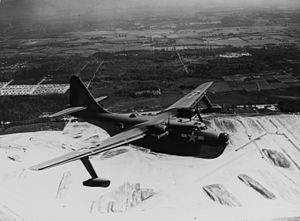Boeing XPBB Sea Ranger
| XPBB-1 Sea Ranger | |
|---|---|
 |
|
| Role | Prototype patrol aircraft |
| Manufacturer | Boeing |
| First flight | 9 July 1942 |
| Retired | 1947 |
| Status | Prototype |
| Primary user | United States Navy |
| Number built | 1 |
The Boeing XPBB-1 Sea Ranger (Boeing 344) was a prototype twin-engined flying boat Patrol Bomber built for the United States Navy. The order for this aircraft was cancelled to free production capacity to build the Boeing B-29, and only a single prototype was completed.
Well before the United States entered World War II, the Navy started a program to develop a long-range flying boat, able to cover the vast expanse of the Pacific Ocean. The Model 344 design offered by Boeing was chosen, and a contract for 57 aircraft was awarded on 29 June 1940. The designation given to the type was PBB for Patrol Bomber, Boeing, the first aircraft of the PB category built by Boeing for the Navy. Nevertheless, Boeing did have important experience in the construction of large flying boats, having produced the successful Boeing 314 airliner. To build the large PBB, Boeing started construction of a new lakeside factory in Renton, Washington, that was owned by the US Navy. However, the prototype was constructed mostly in Seattle, and was moved to Renton only to be completed.
To achieve the desired long range, the PBB became a quite large aircraft, with a wing span of 139 feet 8½ inches (42.59 m) and a crew of 10. Despite this size, it was powered by just two Wright R-3350 Duplex Cyclone radial engines, driving three-bladed Curtiss Electric propellers. It was the largest twin-engined flying boat flown during World War II. For a flying boat, the PBB was aerodynamically clean, with a cantilever wing set high on the fuselage. The planing bottom had a single step, and the non-retractable outrigger floats were attached to streamlined, cantilever struts. The lower hull was divided in seven watertight compartments, and a short upper deck provided seating for the cockpit crew. The wing of the PBB was constructed in a centre section and two outer panels. The centre section carried the engine nacelles and contained the internal bomb bays, as well as fuel and oil tanks. The outer wing panels contained main and auxiliary, integral fuel tanks.
The defensive armament of the PBB consisted of five powered turrets equipped with Browning .50 M2 machine guns. They were installed in the nose, in the tail, on the upper fuselage just aft of the trailing edge of the wing, and in two waist positions on the rear fuselage. Except for the waist guns, the turrets had two guns each. Offensive armament could consist of up to 20,000 lb of bombs in internal bomb bays in the wing center section (five bays on each side) or of two Mk.13 or Mk.15 torpedoes slung under the wing centre section.
...
Wikipedia
